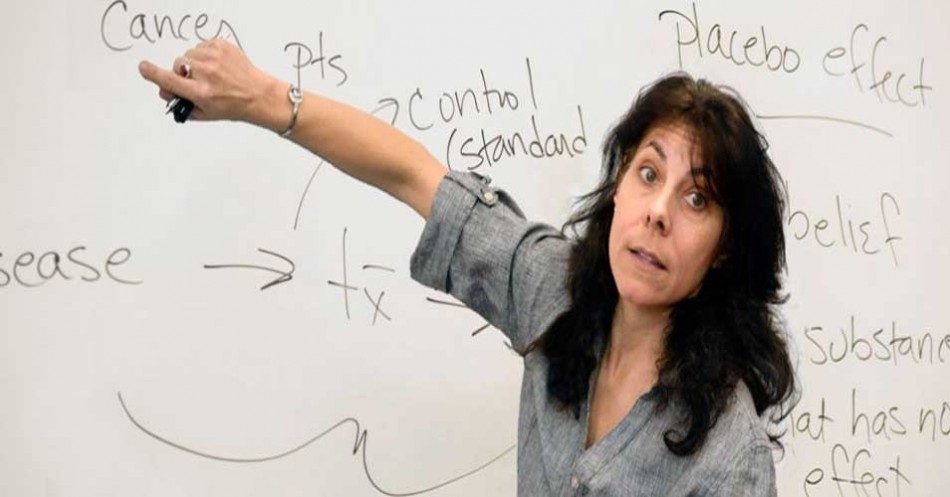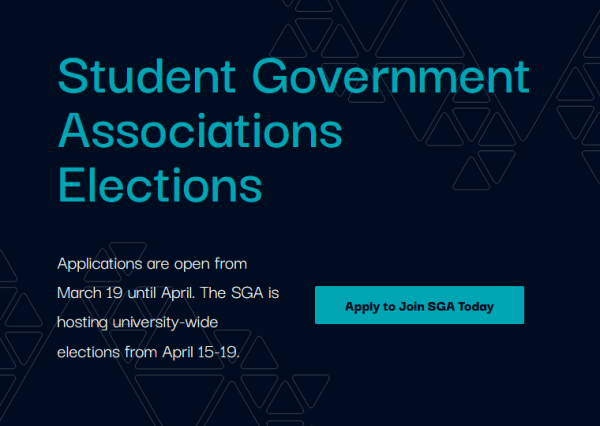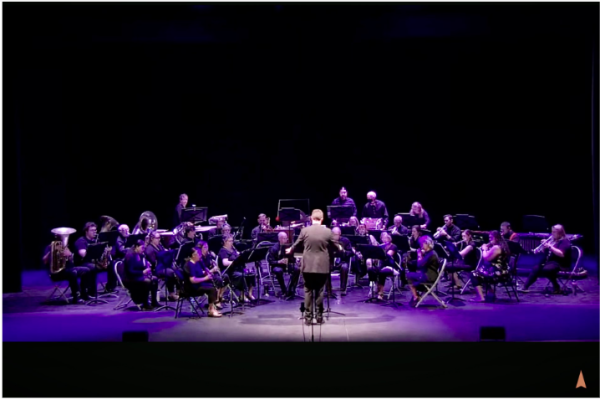For students and professors alike, mounting texbook prices are an issue
Gina Mireault in the classroom
According to The College Board, the average amount a student spent on books and materials in the 2014-15 school year was $1,125 for a four-year institution, certainly significant when students are already coming out of school with an average of $28,400 in debt, according to a 2013 study by The Institute for College Access and Success.
With many textbooks costing more than $100, students are left to wonder if professors are sensitive to the issue of book prices when assigning their texts.
For Gina Mireault, the answer is a definite yes. “One of the top two factors I consider, when I consider a textbook, is the price,” said Mireault, professor and co-chair of behavioral sciences. “I certainly have thought, ‘My God, if my kids needed to spend $500 per semester on books or more, that’s a significant expense over the course of two college degrees.’ That’s about $10,000.”
Balancing price and appropriateness is part of how Professor of Environmental and Health Sciences Robert Genter chooses texts. “I’m teaching a course on lakes this semester, and the cost of a book ranged anywhere from $80 to $150,”he said. “And so I went with the least expensive one.”
Genter also noted that many books, especially science books, are more expensive simply because they have colored images rather than black and white. “The cost of books is certainly something we consider, but it’s not an easy decision sometimes,” he said.
Of increasing concern to both some professors and many students is the publishers’ policy of frequently publishing new editions even when new content does not seem to justify the price. “Part of what publishers do is they come out with these new editions, and that replaces the old edition,” said Mireault. “And most of the time, the new edition has nothing that justifies the increase in price. It’s just a newer edition, and it allows them to get rid of the old edition. So that’s really infuriating.”
Heather St. Arnault, JSC junior, said that in her experience, new editions hardly even differ from the older editions.
“Most of the time it only adds a few new words,” said St. Arnault. “A lot of professors even admit it. And it’s just like, why are you having the students get the new textbook when you don’t even need it? It’s ridiculous.”
So what drives the choice to use textbooks for the classroom? And what makes a professor decide which textbooks to use?
“It has to have the appropriate content, it has to have the content at the right level, the textbook has to be affordable, it has to be understandable… and not necessarily in that order,” said Les Kanat, professor of environmental and health sciences.
Kanat said that he will often link students to websites to purchase their textbooks for significantly less money.
For some professors, textbooks just aren’t worth the cost anymore. Mireault said that in an age when we have instant access to information, she prefers to find other ways to teach her students.
“I try not to use any textbooks,” Mireault said, “partly because textbook information in my field can be quickly outdated… I don’t think students require a textbook to have access to that information anymore. Information is so widely available. So what I try to do is find resources online.”
When she does have to get textbooks for her students, Mireault asks the bookstore to get previous editions so they will be less expensive. She said that they will also often notify her if there’s a previous edition available.
“I’ll only do it again if I feel like there’s no other way that I can get this information to them in a way that’s going to make sense,” Mireault said, “or that’s going to be less effort or cleaner or [provide] a better education. If I can do it as well as a textbook, then I will.”
Mireault’s change in perspective came when her son entered college and discovered the textbooks there were open-access, meaning that textbooks were available at the library, the teachers gave them copies, etc.. He went throughout his entire undergraduate engineering program without ever having to purchase a single textbook.
“I felt for the first time… first of all, it just opened my eyes to the textbook issue,” Mireault said. “And it also gave me incredible permission to not use textbooks. I had just never considered that maybe you don’t need a textbook, even in a discipline like mine. So now, if it’s possible, I don’t have textbooks.”
St. Arnault said that she wishes more professors would take this kind of approach instead of choosing textbooks for their students.
“A lot of the books I’ve gotten for my classes, we don’t end up using, really,” St. Arnault said. “We only read a couple chapters, and sometimes the teachers print off stuff from a book or from outside sources and just give it to us. I wish more teachers would actually do that instead of having their students spend so much for every single book. It’s ridiculous.”
According to Mireault, this is another fault in textbooks: they are so broad thatprofessors hardly ever have students read all of it.
“I would prefer to have fewer topics that we go into in more depth,” Mireault said. “A textbook is kind of designed to give broad overviews. So let’s say the textbook has twenty chapters. As an instructor, I might only want to cover 10 of those. And that means there’s 10 chapters that students are paying for that we’re never getting to… I hear that from a lot of professors, that they prefer depth over breadth.”
Genter tries to find books that allow him to follow it as closely as he can.“I use textbooks in all of my courses, and now I incorporate them into the course more, so that students have their book open and are answering questions from the book,” he said. “I’ve tried the best I can to get books with good questions in them so I can do that. I think it’s very important that if we’re going to spend that much money on a book, we’d better use it. When I was an undergrad, I had courses where I’d buy a book and it just never seemed like we actually used the thing. That’s a complete waste of money.”
Karen Madden, director of academic support services, teaches some classes at JSC as well. She has had the bookstore compile certain sections of textbooks into one book for students; they have to pay for the copyright for each section, but the result is cheaper than buying all of the different books separately.
Madden has also taken to the use of open educational resources when possible.
“There are some open educational resources available now that are on the internet,” said Madden. “I developed a history of the ‘60’s using just open educational resources so there’s no cost whatsoever to students, and there’s no copyright.”
JSC junior Devon Kinloch has had experience with professors using open educational resources, which was easy for students to access when they needed it.
“I’ve also had classes where the teacher would hand out notes rather than go off of a textbook,” said Kinloch. “I think those systems worked well, even though they might be more work for the teacher.”
St. Arnault and Paul Massey, also a junior at JSC, said that they often turn to Amazon to buy their textbooks, as it’s significantly cheaper than the bookstore.
“Science books are usually about the same no matter where you buy them,” said Massey, “whereas other books that I need for other classes weren’t bad, because I could go online and get them [used] for one cent, whereas the bookstore was trying to sell them for like $20.”
Genter brought up another alternative; many publishers offer books in an electronic format, often available for rental. This can be much cheaper than even renting a used book.
Another method that students turn to in order to buy textbooks is the Student Emergency Fund, which students can apply to for modest financial help from the office of Academic Support Services.
According to Madden, the emergency fund is funded by staff and faculty donations. Because of this, students are limited to $150 once per year.
“$150 is often not even enough to buy one book,” said Madden. “It helps, so that’s about all we can do.”
Madden estimated that about 90 percent of the applicants for the emergency fund cite textbooks as the reason for needing the money.
Academic Support Services also keeps a supply of textbooks, some of them older editions, to help out students who can’t afford their books.
Alternative sources for textbooks, however, are not always options. Cara Conroy, a JSC sophomore, is usually not able to be spared the extra expense of buying from the bookstore.
“A lot of times, I actually do have to get them through the bookstore,” she said, “because a lot of teachers will wait to tell you what you need, so when you’re already in the first week and you need to do a reading by the next class, you genuinely have to go and get it that day. But if I have prior notification, I will order it online from wherever is cheapest.”
For Conroy, as well as many other students nationwide, the extra expense, usually out-of-pocket, is simply too much to bear.
“We’re already paying tuition, room and board…” said Conroy. “With all of these outrageous fees, it’s not really fair that we have to come in here and spend upwards of $600 on textbooks.”
So the question stands: when information is so widely available, are these textbooks worth the added debt?
“It’s a big problem, for sure,” said Madden.
Kinloch would no doubt agree: the most expensive textbook required for a course was $250, and it was a paperback.








